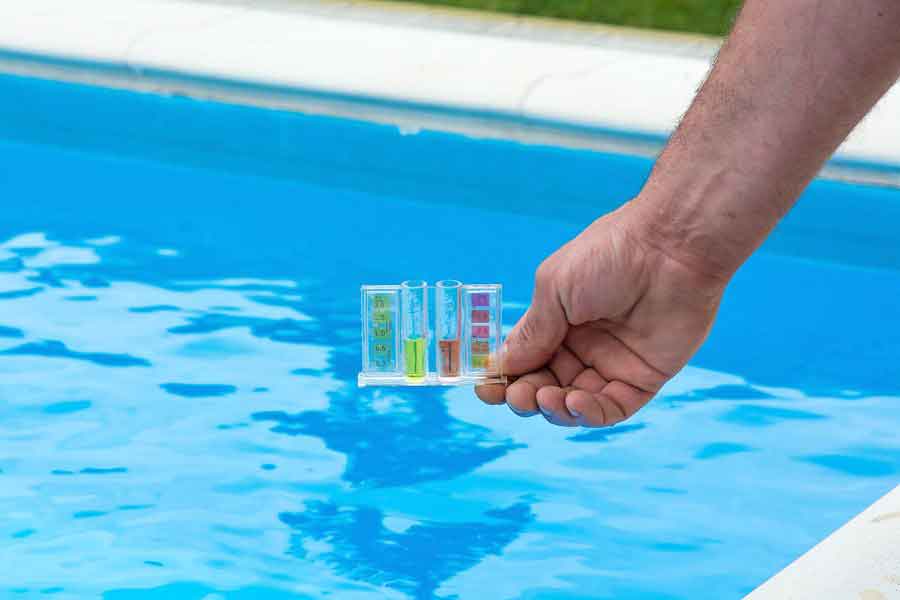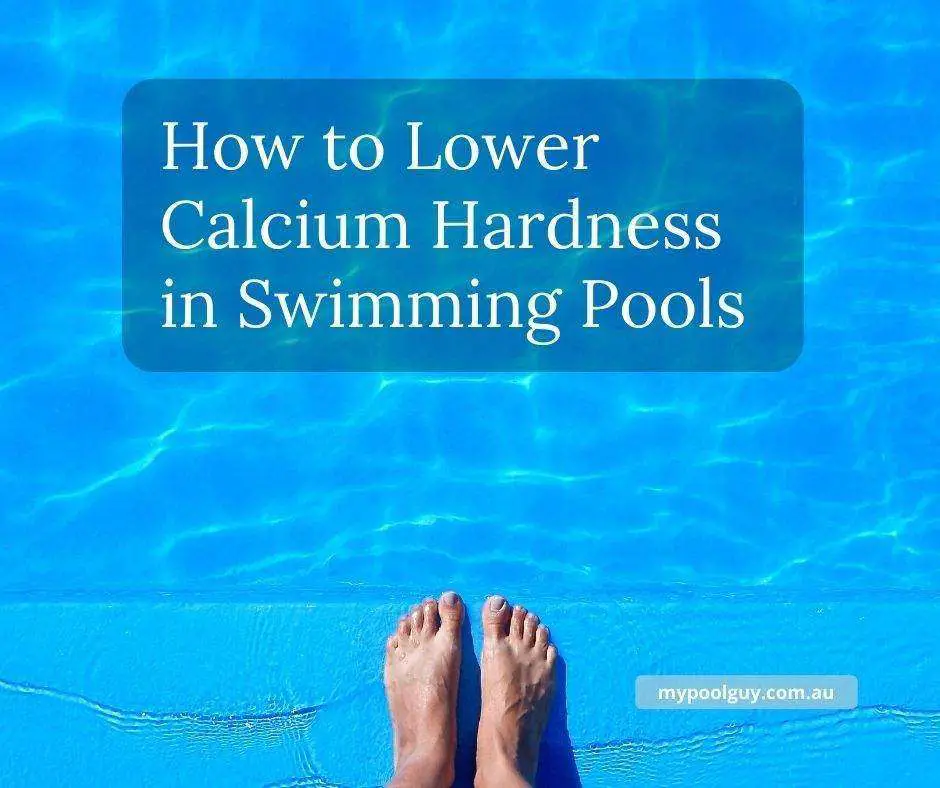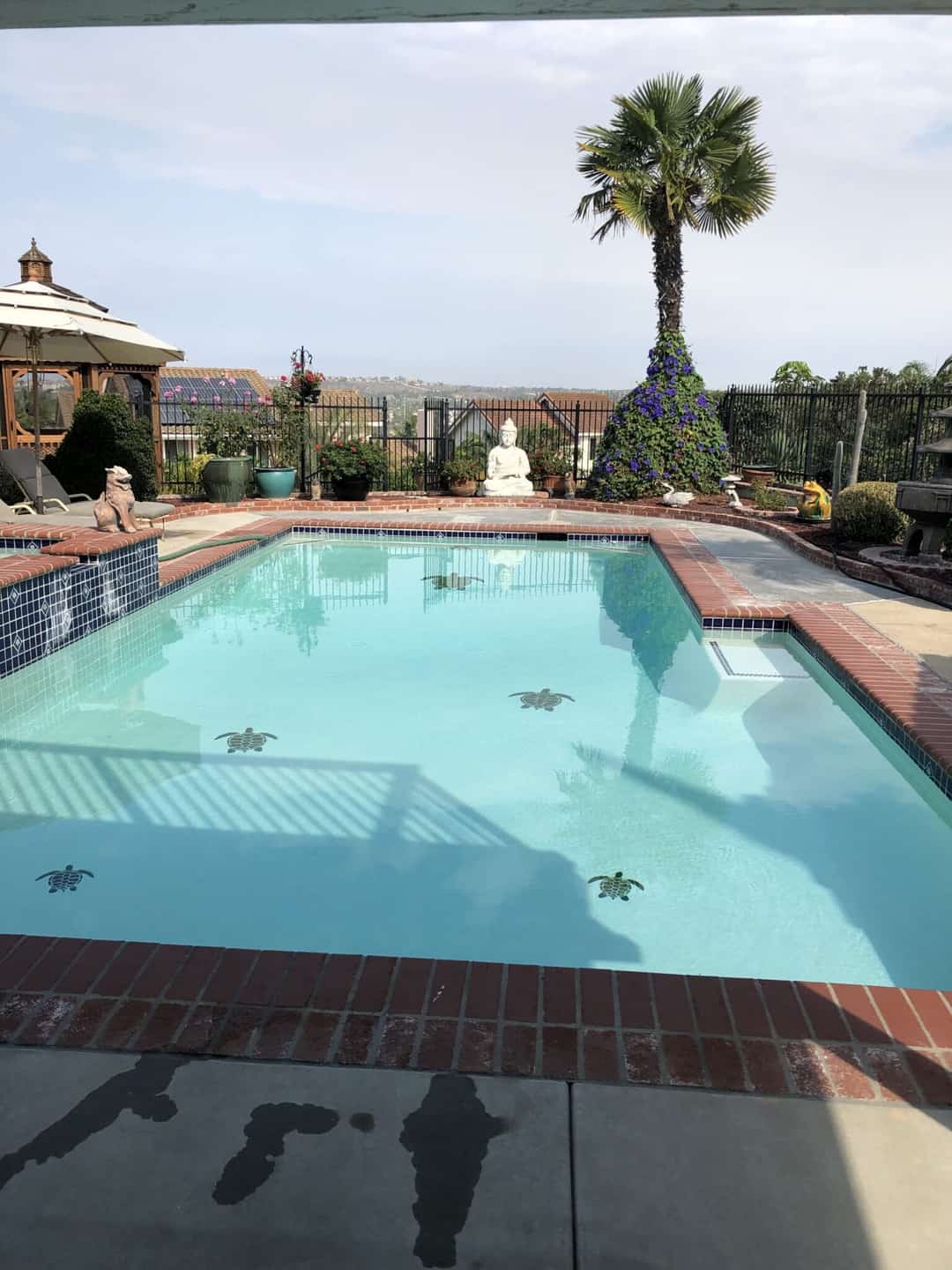How To Lower Calcium Hardness Levels
If you know for sure that your pools calcium hardness levels are too high, dont fret. There are a few simple processes thatll help you get your pool shipshape.
Replace Some of the Water
If your water is high in calcium, use a filter to get the minerals out.
If you dont want to remove some of the water from your pool, you can use pool flocculant. However, before you use it, turn off both your filter and pump before adding the flocculant. Otherwise, youll have to replace your filter medium if the flocculate gets in it. If your pool uses a cartridge filter, dont use flocculant.
Flocculant is a chemical that will cause the calcium buildup to clump together. When you start seeing these clumps pop up, you can use your vacuum to remove these bits of calcium.
Use Muriatic Acid as a Last Resort
This isnt an ideal situation, but if youre still having trouble, try some muriatic acid. Though this chemical doesnt lower the calcium hardness in your pool, it does increase the level of saturation, which can balance out your pool water.
Maintaining A Hard Water Pool
There are many pools that operate in the 400-800 ppm range, with special care of pH and alkalinity, and use of a Stain & Scale chemical, to keep the water clear and prevent precipitation and scale formation on plaster, steel and tile surfaces.
The most important thing with hard water pools is to maintain low pH and low Alkalinity levels, especially as the water temperature increases each summer. Hard water pools are less likely to become cloudy or produce scale when the pH level is kept around 7.2 and Alkalinity is below 100 ppm.
The second most important thing with a hard water pool is to make regular use of a good Stain & Scale chemical, aka sequestrants or chelators. These chemicals bind up minerals and metals to keep them dissolved, to prevent staining and scaling, but they deplete rapidly. Add an initial dose each spring, and maintenance dosages every week or two, for continuous protection from cloudy water, stains and scale.
Thirdly, for pools with high calcium hardness levels, you may want to discontinue use of calcium hypochlorite pool shock, which adds a small amount of calcium to the pool when used. You can use Dichlor, Lithium, Non-Chlorine Shock or bleach as alternatives to Cal Hypo pool shock.
To more accurately determine your pool waters propensity for scaling, which is the main concern with hard water pools, you can run a Langelier Saturation Index, using the Pentair LSI calculator.
How Dangerous Are The Chemicals
While sodium bicarbonate is certainly not going to hurt you if it comes into contact with your skin, precautions should still be used. Minimally, using a respirator, and eye protection will keep you safe.
Calcium chloride on the other hand, when mixed with water, has an exothermic reaction, which is to say, it gets hot! So make sure you use a respirator, eye protection, and definitely wear gloves to keep your hands safe!
Don’t Miss: Mandalay Bay Pool Club
Calcium Hardness In Fibreglass Pools
Some pool shops are unaware that the calcium levels in fibreglass pools is often different to concrete pools. Consequently, some pool shops will incorrectly advise customers to significantly increase the calcium levels in their water. This mistake happens because the water testing software used at pool shops is primarily designed for concrete pools rather than fibreglass. Remember, most concrete pools have a suggested calcium range of 200-300ppm while fibreglass pools are often much lower.
So, to ensure that your water is at the right level, check the suggested calcium levels with your pool manufacturer. For example, the pool shown here is from a client who had heavy calcium build-up on their fibreglass pool from poor water balance. In addition to surface problems, excessive calcium in a fibreglass pool can clog salt cells, damage the heater, and obstruct pipework.
How Do I Remove Calcium Off My Pool Surface

If you spot calcium lumps or blotches in your pool, please dont alter your calcium hardness to try and fix this issue. Often, some people advise that reducing your calcium hardness will dissolve the calcium on the pool surface. This is not true. For example, maintaining the calcium level at either extreme will only make the calcium formation worse, not better. Therefore, the only way to treat calcium formation on a pool surface is to either use a calcium dissolving compound, or to drain and acid wash the pool.
If you have calcium lumps, streaks or blotches forming in your pool, please contact us for information. Remember, we can help you remove these without draining your pool water.
References
Also Check: How To Convert Chlorine Pool To Saltwater Pool Cost
If Levels Are Too Low
As was already mentioned, low calcium levels can be just as bad as high levels because they can corrode your pool and pool equipment.
Fortunately, increasing hardness levels is a whole lot easier than lowering them. The best remedy for soft water is to add something called calcium hardness increaser, which is calcium chloride in granular form.
To know how much to add, youll need to know your pool volume. Youve got to be careful because when calcium chloride comes into contact with water, it releases heat in an exothermic reaction.
Thats why you need to wear protective gear when doing this sort of thing.
What’s The Ideal Calcium Hardness Level For A Hot Tub
The ideal calcium hardness range for a hot tub is 80-200 ppm.
These ranges are a good guideline because anything above or below means your water is way out of range.
And anything above 1,000 ppm is considered EXTREMELY high.
These levels will always vary slightly, and actually, each hot tub manufacturer usually list their own ranges for their specific hot tub models.
Don’t Miss: How To Tell If Your Pool Is Leaking
Chemical Water Softener For Pools
Using commercial pool products such as chemical water softener for pools to remove the hardness is another means of getting rid of the calcium levels.
They can be used once off if the hardness in your pool is in accumulation, or can be added weekly if the fill water is very hard.
Keeping the pH a little low can prevent scale problems associated with hard water.
One of such products to try is a liquid product called Metal-Out . I think it also has something relating to stain removal in sub-title under product name. Comes in a quart bottle. Follow manufactures instructions & you should be in business.
Still need more recommendations, you can continue reading for more ideas on how to reduce calcium hardness in pool.
ALSO SEE: How To Remove Water Hardness & Soften at Home
What If The Water Is Too Soft
How is this even possible? How can water be too soft? Well, when its the water in your pool, its definitely a concern.
Too-soft water will be corrosive to your pool. It can dissolve concrete and plaster, and corrode any metal parts submerged in or touched by the water. It all amounts to expensive repairs if you dont bring the calcium hardness level back up.
Don’t Miss: How To Lower Cya In Pool
Treating High Calcium Hardness
Reducing high calcium hardness is very difficult. The easiest way to do this, although it doesnt always work, is to replace some of the water with fresh water. If that does not work consult a pool professional, as they will have to add a chemical to keep the calcium in solution that prevents it from depositing.
The Role Of Calcium Hardness In Water Balance
While hardness in water consists of both calcium and magnesium salts , only the calcium component is relevant in the water balance calculation for pools and spas. Called the Saturation Index formula, it considers the interrelationships of four chemical factorscalcium hardness pH total alkalinity, as corrected for the contribution of any cyanuric acid stabilizer in use and, to a much lesser extent, the total dissolved solids levelplus one physical factor, water temperature. All but the mathletes among us use a water balance calculator like Taylor Technologies’ Watergram® to do the number crunching involved. The value one arrives at reflects the water’s degree of saturation with calcium carbonate.
When the SI value is zero, the water is properly balanced. Its calcium hardness, pH, and total alkalinity are acting in harmony with one another. When the SI is +0.5 or more, the unbalanced water is trending toward scaling, meaning conditions are right for calcium carbonate to come out of solution and deposit on surfaces as “scale.” When the SI is -0.3 or less, the unbalanced water is trending toward corrosivity. Corrosive water attacks plaster, concrete, grout, and metal, resulting in etching, pitting, and surface stains and/or colored water caused by metal pulled out of piping, fittings, and equipment.
You May Like: How To Lower Cya In Pool
The Effects Of High And Low Hardness
Specifically, water with high calcium hardness gets cloudy unless the alkalinity and/or pH are low enough to compensate. As mentioned, the excess calcium carbonate will precipitate as crusty, grayish white scale on surfaces, piping, and equipment. It’s unsightly, can cause abrasions on users and snag bathing suits, and makes a good anchor for microorganisms. It will clog filters. When it builds up in piping, circulation is reduced and pressure increases. Scaling is an especially acute problem in heaters because calcium’s solubility is inversely proportional to temperature: As temperature increases, less calcium is able to stay dissolved. Scale on the pipes or coils acts as an insulator, slowing heat transfer. This makes it more expensive to heat the water. Over time, thick scale will cause a heater to fail.
Water with low calcium hardness will seek more by dissolving it from surfaces it comes in contact with that contain calcium, such as plaster, grout, and concrete decking. The late Dr. Neil Lowry, a well-respected instructor in our industry, preferred to call water with low calcium hardness “aggressive” rather than “corrosive” because the latter term implies the destruction of metals. The corrosiveness of unbalanced water, he would tell his students, comes from poorly maintained alkalinity and pH.
|
|
|
|
|
|
Calcium Hardness In Pools

The main reason that your concrete swimming pool may have a high calcium hardness is because of the concrete surface. In this case, a concrete surface will release calcium hydroxide into your pool water. However, this increase in calcium is reduced when water is removed from your pool. For example, splashing out water when swimming, or back washing the filter all remove water from your pool. Because of this, most pools do not suffer from increasing calcium levels over time.
Also Check: Black Hose Trick Pool Heater
Alkalinity And Calcium Hardness In Daily Operations
Alkalinity and calcium hardness dont fluctuate nearly as much as pH or chlorine so monitoring them only needs to be done once a day, and can be checked using a titration kit, or a .
A good way to track your alkalinity and calcium hardness levels over time, is using the Chemical Records Module in DigiQuatics.
Optimal range for alkalinity is roughly between 60-120 ppm. Just remember, the higher you go, the harder time you will have affecting change on your pH, in either direction.
Calcium hardness should be kept at 250 ppm minimum. Once full, getting your pool to 250 ppm is important from there if youre using calcium hypochlorite to add chlorine to your pool your calcium hardness will steadily increase. There is no real reason to lower your hardness. At several of the facilities Ive worked for, before we drained and refilled the pool the calcium hardness could get up to 2300 ppm without issue!
Further information on Alkalinity, Calcium Hardness, and other pool chemicals can be found here.
Interested in our e-book? The Crash Course for Pool Operators?
Sign up here to get updates about the e-book as we get closer to releasing it!
Have any questions or experience with these chemicals? Let us know below! Were happy to answer questions!
Why Do We Need To Lower Calcium Hardness In Swimming Pools
We need to lower the calcium level properly maintain the balance of pool water. It is one of the most difficult parts of owning a pool. The calcium hardness levels in your pool can often prove to be particularly troublesome to pool owners.
How do we lower calcium in pools?
- Test the water
First, check the pool water level before trying to lower calcium hardness. To know the current level of calcium in your pool.
- Determine how much water to drain
Determine how much water you need to drain and water that you need to add. Remember to add fresh water every time to lessen the water in your pool.
Also Check: Vdara Indoor Pool
How Do I Adjust My Calcium Hardness
If your calcium hardness is too low, it can be increased by adding calcium chloride from your pool shop. Adding calcium to your pool will increase the calcium level right away. On the other hand, if the calcium hardness is too high, then we suggest pumping out some water from the pool and replacing it with tap water as mentioned above. Remember, bringing the calcium to the right level is inexpensive, permanent, and will make the water feel great again.
If you dont know your calcium hardness level, we suggest getting it tested as soon as you can. Also, if your pool shop is not equipped to test for calcium hardness, try another shop. Importantly, all surfaces can react with calcium, the calcium level is important to know .
How To Lower Hardness In Pool
Wondering why there is damage on your pool surfaces? We will explain why it is related to high calcium and show you how to lower hardness in pool.
How To Lower Hardness In Pool | Sage Bathroom
While you may have already learned how to test the waters pH, chlorine levels, and total alkalinity, identifying how to lower hardness in pool is equally important.
Hardness is theproportion of calcium and magnesium in pool water. When water is excessivelyhard, white scale develops on a pool surface. When it is overly soft, equipmentweakens and rusts. In a nutshell, it causes real damage over time when notbalanced.
Contents
Don’t Miss: When Does The Ymca Outdoor Pool Open
How To Lower Hardness In A Pool
If youre dealing with too much calcium in a pool, you can try adding a sequestering agent, which is a chemical treatment that fights the effects of high metal and calcium content in swimming pool water . If you routinely struggle with high calcium levels or if you live in a place where hard water is an issue, you should make a sequestering agent part of your regular chemical maintenance program.
Of course, when dealing with any swimming pool issue from calcium problems to questions about routine maintenance — your local pool professional is a great resource. They can prescribe what is best for your pool to take care of and prevent any problem that can arise.
Beware The Fading Endpoint
Occasionally when testing calcium hardness you may get a purple endpoint instead of blue. This is called a “fading endpoint” and is due to interference from metal ions . Retest, but prevent the interference by adding five or six drops of hardness reagent to the sample before adding the buffer and indicator. Then proceed as usual. Remember to count the drops of titrant added at the beginning when you calculate the total number of drops required to reach the endpoint.
Don’t Miss: Aria Hotel Pool
Magnesium Will Show As Calcium In A Water Test
This is because the reagents that measure calcium hardness will also include the magnesium salts that are in your water. This means that your calcium hardness reading will be substantially higher, even though it may be at the right level. In short, if you have a tested calcium hardness level of 800ppm the actual calcium level will be closer to 200ppm. Also, make sure your pool shop actually knows about MagnaPool! Finally, this information is verified on the MagnaPool website which discusses this issue in greater detail.
How To Treat Hard Pool Water

While owning a swimming pool has a lot of benefits like an area for relaxation during the hot summer days and a great venue for house parties with friends, this too requires a lot of responsibilities.
One of the concerns that many pool owners have to consider is when the water becomes too hard for swimming.
What does hard pool water mean? And is it really dangerous?
In this article, we will explain the factors that contribute to making pool water hard, necessary steps to soften it, and some tips and reminders.
You May Like: Frog Pool System Vs Salt Water
Lowering Your Calcium Hardness With A Flocculant:
in-solutionout-of-solution
Calcium Reductionthe Natural Way
One way to reduce calcium hardness is to pump out water using your pool cleaner or vacuum hose. Doing this during long periods of soaking rain when your pool is likely to overflow is best. In short, this method removes the high calcium water from the pool while at the same time, the rain refills it with fresh water that contains no calcium. So, doing this several times a year can have a huge impact on the calcium levels in your water. And its free!
Also Check: Ways To Hide Pool Pump
